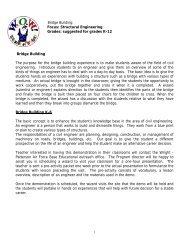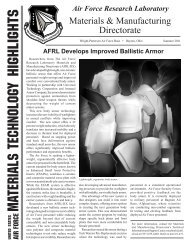- Page 1:
The PythagoreanTheoremCrown Jewel o
- Page 4:
The Pythagorean TheoremCrown Jewel
- Page 7 and 8:
Table of ContentsList of Tables and
- Page 9 and 10:
List of Tables and FiguresTablesNum
- Page 11 and 12:
Figures…continuedNumber and Title
- Page 13 and 14:
List of Proofs and DevelopmentsSect
- Page 15 and 16:
PrefaceThe Pythagorean Theorem has
- Page 17 and 18:
1 : 2x2x2****22 13x 7 13x 7 0 : a
- Page 19 and 20:
1) Consider the Squares“If it was
- Page 21 and 22:
s090045 0ss45450450090Figure 1.3: O
- Page 23 and 24:
Notice that the right-triangle prop
- Page 25 and 26:
The middle square (minus the donut
- Page 27 and 28:
Our proof in Chapter 1 has been by
- Page 29 and 30:
2) Four Thousand Years of Discovery
- Page 31 and 32:
The proof Pythagoras is thought to
- Page 33 and 34:
cabcFigure 2.4: Annotated Square wi
- Page 35 and 36:
Figure 2.6 is the diagram for a sec
- Page 37 and 38:
1x:b2:Area(CBA)3:Area( ABC)Area(ABC
- Page 39 and 40:
Euclid’s proof of the Pythagorean
- Page 41 and 42:
First we establish that the two tri
- Page 43 and 44:
1 2y b b: y b c c2:A3:A4:Aunshaded
- Page 45 and 46:
XB'A090 CBFigure 2.12: Euclid’s C
- Page 47 and 48:
2.3) Liu Hui Packs the SquaresLiu H
- Page 49 and 50:
One of my favorites was Boxel, a ga
- Page 51 and 52:
2.4) Kurrah Transforms the Bride’
- Page 53 and 54:
Note: as is the occasional custom i
- Page 55 and 56:
2.5) Bhaskara Unleashes the Power o
- Page 57 and 58:
2.6) Leonardo da Vinci’s Magnific
- Page 59 and 60:
In Figure 2.24, we enlarge Step 5 a
- Page 61 and 62:
But, this is precisely the nature o
- Page 63 and 64:
2.8) Henry Perigal’s TombstoneHen
- Page 65 and 66:
In the century following Perigal, b
- Page 67 and 68:
Returning to Henry Perigal, Figure
- Page 69 and 70:
Figure 2.32 is President Garfield
- Page 71 and 72:
Even though the Cartesian coordinat
- Page 73 and 74: B 2← γ →α y βx C-xC 2Figure
- Page 75 and 76: Being polynomial in form, the funct
- Page 77 and 78: Thus, the critical point ( C 2 ,0)i
- Page 79 and 80: Sincexcpwas chosen on an arbitrary
- Page 81 and 82: ∂F/∂x = ∂F/∂y = 0x(C - x) 2
- Page 83 and 84: Define a new function21 A2 A3 2xcp
- Page 85 and 86: 2.11) Shear, Shape, and AreaOur las
- Page 87 and 88: Step 1: Cut the big square into two
- Page 89 and 90: In Table 2.3, we briefly summarize
- Page 91 and 92: We can formally state this similari
- Page 93 and 94: What we will do in Section 3.2 is p
- Page 95 and 96: There are three Pythagorean-triple
- Page 97 and 98: Thus, if we multiply any given prim
- Page 99 and 100: The last equality shows that the in
- Page 101 and 102: A Pythagorean Quartet is a set of f
- Page 103 and 104: 3.5) Pythagoras and the Three Means
- Page 105 and 106: yxy MHxab2ab2 y x FC y ab2ab 2ab y
- Page 107 and 108: Hero was the founder of the Higher
- Page 109 and 110: 5 : Solve for area using the formul
- Page 111 and 112: 4 : Construct the parallelogram wit
- Page 113 and 114: We already have introduced Thabit i
- Page 115 and 116: Some historians believe Stewart’s
- Page 117 and 118: In pre-computer days, both all four
- Page 119 and 120: One example of a periodic process i
- Page 121 and 122: The six trigonometric functions are
- Page 123: The following four relationships ar
- Page 127 and 128: Figure 3.17 can be used as a jumpin
- Page 129 and 130: The remaining two pillars are the L
- Page 131 and 132: a2Law of Cosines c2 b2 2bccos()The
- Page 133 and 134: An example of a Diophantine equatio
- Page 136 and 137: However, Euler’s Conjecture did n
- Page 138 and 139: 4) Pearls of Fun and WonderPearls o
- Page 140 and 141: We have achieved five-digit accurac
- Page 142 and 143: 140212213116)74370116)(74370(370)74
- Page 144 and 145: X X X X O X X O X XO X X O O OO X O
- Page 146 and 147: 4.3) Earth, Moon, Sun, and StarsIn
- Page 148 and 149: The four-step solution follows. All
- Page 150 and 151: Figure 4.9 depicts Eratosthenes’
- Page 152 and 153: ---High above the earth, we see the
- Page 154 and 155: The commonly accepted value is abou
- Page 156 and 157: 1BC : tan( BAC)BABC BAtan(BAC)0BC
- Page 158 and 159: BD ACtan( 21 )Even for the closest
- Page 160 and 161: 3w 2h s w 5 s w 0.38196s&5 1s
- Page 162 and 163: Figure 4.16: Triangular Phi---The h
- Page 164 and 165: What remains to be done is to devel
- Page 166 and 167: 3 : h32 4 h222 2 24C 2 h33162 2 2
- Page 168 and 169: Epilogue: The Crown and the Jewels
- Page 170 and 171: Not only has it endured, but the Py
- Page 172 and 173: A] Greek AlphabetGREEK LETTERUpper
- Page 174 and 175:
C] Geometric FoundationsThe Paralle
- Page 176 and 177:
8. Congruent Triangles: Two triangl
- Page 178 and 179:
3. Rectangle: A bh : P 2b 2h, b &
- Page 180 and 181:
Recreational Mathematics11. Pickove
- Page 182 and 183:
GGolden RatioDefined and algebraica
- Page 184 and 185:
Puzzles (cont)Pythagorean Magic Squ
- Page 186 and 187:
Pythagorean Theorem ProofsAlgebraic
- Page 188:
Trigonometry (cont)Eratosthenes mea

















